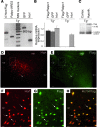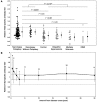Elevated Tribbles homolog 2-specific antibody levels in narcolepsy patients
- PMID: 20160349
- PMCID: PMC2827962
- DOI: 10.1172/JCI41366
Elevated Tribbles homolog 2-specific antibody levels in narcolepsy patients
Abstract
Narcolepsy is a sleep disorder characterized by excessive daytime sleepiness and attacks of muscle atonia triggered by strong emotions (cataplexy). Narcolepsy is caused by hypocretin (orexin) deficiency, paralleled by a dramatic loss in hypothalamic hypocretin-producing neurons. It is believed that narcolepsy is an autoimmune disorder, although definitive proof of this, such as the presence of autoantibodies, is still lacking. We engineered a transgenic mouse model to identify peptides enriched within hypocretin-producing neurons that could serve as potential autoimmune targets. Initial analysis indicated that the transcript encoding Tribbles homolog 2 (Trib2), previously identified as an autoantigen in autoimmune uveitis, was enriched in hypocretin neurons in these mice. ELISA analysis showed that sera from narcolepsy patients with cataplexy had higher Trib2-specific antibody titers compared with either normal controls or patients with idiopathic hypersomnia, multiple sclerosis, or other inflammatory neurological disorders. Trib2-specific antibody titers were highest early after narcolepsy onset, sharply decreased within 2-3 years, and then stabilized at levels substantially higher than that of controls for up to 30 years. High Trib2-specific antibody titers correlated with the severity of cataplexy. Serum of a patient showed specific immunoreactivity with over 86% of hypocretin neurons in the mouse hypothalamus. Thus, we have identified reactive autoantibodies in human narcolepsy, providing evidence that narcolepsy is an autoimmune disorder.
Figures



Comment in
-
Sleep: Narcolepsy--a role for TRIB2 autoantibodies?Nat Rev Neurol. 2010 May;6(5):238. doi: 10.1038/nrneurol.2010.41. Nat Rev Neurol. 2010. PMID: 20455283 No abstract available.
-
Furthering the understanding of the pathophysiology of narcolepsy.Curr Neurol Neurosci Rep. 2011 Apr;11(2):127-30. doi: 10.1007/s11910-010-0165-8. Curr Neurol Neurosci Rep. 2011. PMID: 21125429 No abstract available.
References
Publication types
MeSH terms
Substances
LinkOut - more resources
Full Text Sources
Other Literature Sources
Medical
Molecular Biology Databases

